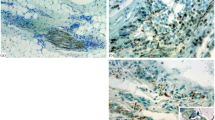Summary
The presence and distribution of types I, III, IV and V collagens within open lesions in the rat cerebrum have been demonstrated by immunofluorescent techniques. In the adult animal, types I and III collagens can be identified in the cicatrix from eight days onwards. Types IV and V collagens occur in the basement membrane of the glia limitans formed between the neuropile and the cicatrix and in the basement membranes of the blood vessels. In neonatal animals, less than eight days old at operation and allowed to recover for eight days, no type I or III collagens occur in the lesion and no types IV and V are present along the edge of the neuropile, because a glia limitans is not formed. In animals operated on when eight days old, the adult response is found in the cortex only, but when 16 days old the full adult response occurs in all parts of the lesion.
Similar content being viewed by others
References
Abercrombie, M., Flint, M. H. &James, D. W. (1956) Wound contraction in relation to collagen formation in scorbutic guinea pigs.J. Embryol. exp. Morph. 4, 167–75.
Abercrombie, M., James, D. W. &Newcombe, J. F. (1960) Wound contraction in rabbit skin, studied by splinting the wound margins.J. Anat. 94, 170–82.
Bailey, A. J. &Sims, T. J. (1976) Chemistry of collagen cross-links.Biochem. J. 153, 211–15.
Berry, M., Maxwell, W. L., Logan, A., Mathewson, A., McConnel, P., Ashurst, D. R. &Thomas, G. H. (1983) Deposition of scar tissue in the central nervous system.Acta neurochirurgica, suppl.32, 3153.
Charlton, C. A. C., Higton, D. I. R., James, D. W., Nicol, A. R. &Stewart, J. O. (1961) Experimental surgery; wound contraction in the guinea pig.Br. J. Surg. 49, 96–102.
Duance, V. C. &Bailey, A. J. (1983) The nature, structure and function of the vascular basement membrane. InBiochemical Interactions at the Endothelium (edited byCryer, A.), pp. 41–78. Amsterdam: Elsevier Science Publishers.
Duance, V. C., Restall, D. J., Beard, H., Bourne, F. J. &Bailey, A. J. (1977) The location of three collagen types in skeletal muscle.FEBS Lett. 79, 248–52.
Heathcote, J. G. &Grant, M. E. (1981) The molecular organization of basement membranes.Int. Rev. Connective Tiss. Res. 9, 191–264.
Higton, D. I. R. &James, D. W. (1964a) The force of contraction of full-thickness wounds of rabbit skin.Br. J. Surg. 51, 462–6.
Higton, D. I. R. &James, D. W. (1964b) The effect of potassium cyanide on wound contraction studiedin vitro.Br. J. Surg. 51, 698–701.
Lehto, M. (1983)Collagen and Fibronectin in a Healing Skeletal Muscle Injury, Academic dissertation, University of Turku.
Lehto, M., Duance, V. C, Restall, D. J. & Bailey, A. J. (1984) An immunohistochemical study of the effects of various states of physical activity on the repair of injured rat gastrocnemius muscleJ. Bone Joint Surg. (in press).
Luccioli, G. M., Kahn, D. S. &Robertson, H. R. (1964) Histological study of wound contraction in the rabbit.Ann. Surg. 160, 1030–40.
Luccioli, G. M., Robertson, H. R. &Kahn, D. S. (1963) The pattern of contraction during the healing of skin wounds in the rabbit.Can. J. Surg. 6, 499–501.
Madden, J. W., Morton, D. &Peacock, E. E. (1974) Contraction of experimental wounds. I. Inhibiting wound contraction by using a topical smooth muscle antagonist.Surgery 76, 8–15.
Shellswell, G. B., Restall, D. J., Duance, V. C. &Bailey, A. J. (1979) Identification and differential distribution of collagen types in the central and peripheral nervous system.FEBS Lett. 106, 305–8.
Stephens, H. R., Duance, V. C., Dunn, M. J., Bailey, A. J. &Dubowitz, V. (1982) Collagen types in neuromuscular diseases.J. Neurol. Sci. 53, 45–62.
Stopak, D. &Harris, A. L. (1982) Connective tissue morphogenesis by fibroblast traction. 1. Tissue culture observations.Devl Biol. 90, 383–98.
Van Winkle, W. (1967) Wound contraction.Surg. Gynec. Obstet 125, 131–42.
Yamada, K. M. (1981) Fibronectin and other structural proteins. InCell Biology of Extracellular Matrix (edited byHay, E. D.), pp. 95–114. London, New York: Plenum Press.
Author information
Authors and Affiliations
Rights and permissions
About this article
Cite this article
Maxwell, W.L., Duance, V.C., Lehto, M. et al. The distribution of types I, III, IV and V collagens in penetrant lesions of the central nervous system of the rat. Histochem J 16, 1219–1229 (1984). https://doi.org/10.1007/BF01003445
Received:
Revised:
Issue Date:
DOI: https://doi.org/10.1007/BF01003445



